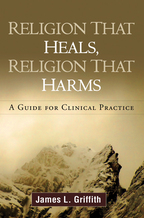Religion That Heals, Religion That Harms
A Guide for Clinical Practice
James L. Griffith
I. A Map for Navigating the Terrain of Religion
1. What Sociobiology Explains about Destructive Uses of Religion
2. What Neurobiology Explains about Destructive Uses of Religion
3. Setting the Stage: Opening Dialogue about Religious Life
4. Locating Personal Spirituality through Existential Inquiry
II. When Religious Life Propels Suffering
5. Seeking a Parent in God: Clinical Problems from Insecure Attachments
6. Seeking Security within the Flock: Clinical Problems from Social Hierarchy, Peer Affiliation, and Reciprocal Altruism
7. Asserting Primacy of Personal Spirituality over Sociobiological Religion
8. The Religious Who Protect Only Their Own: Clinical Problems from Peer Affiliation, Kin Recognition, and Social Exchange
III. When Mental Illness Infiltrates Religious Life
9. Religion That Is a Voice for Mental Illness
10. Dark Nights and Exaltation: Religion Distorted by a Mood Disorder
11. Worlds Confused: Religion Disorganized by Psychosis
12. Fear and Dread: Religion Shrunken by an Anxiety Disorder
IV. A Clinician’s Stance
13. Finding a Place to Stand: Conversing with Religiously Determined Patients



